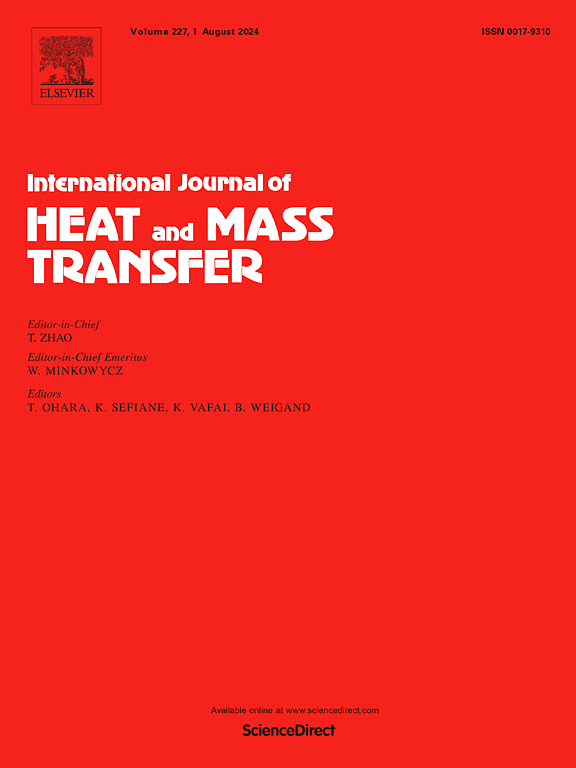The Coupling Effect of Surface Vibration and Micro-structure on Spray Cooling Heat Transfer
IF 5
2区 工程技术
Q1 ENGINEERING, MECHANICAL
International Journal of Heat and Mass Transfer
Pub Date : 2024-11-08
DOI:10.1016/j.ijheatmasstransfer.2024.126409
引用次数: 0
Abstract
Although existing studies have emphasized the effects of micro-structured surfaces and vibration conditions on spray cooling efficiency. However, there is a research gap on how the coupling effect of these two factors affects spray cooling heat transfer. Therefore, in this study, the heat dissipation capacity of spray cooling under different vibration and microstructure size conditions is investigated experimentally using commercial HFE-649 as the coolant. The coolant is an electronic fluid with a global warming potential of only 1. Its low boiling point (49°C), which facilitates the early realisation of the phase change process, has a high potential for application in thermal management systems. The study reveals that both vibration and micro-structured surfaces significantly enhance the heat flux and heat transfer coefficient (HTC) in spray cooling. The combined effect of vibration and microstructures results in a more pronounced enhancement of cooling capacity, with the HTC increasing by 44% compared to a static smooth surface. As the vibration frequency and the side length () of the square fins on the micro-structured surface increase, the heat flux, HTC, critical heat flux (CHF), cooling efficiency, and heat transfer enhancement ratio (HTER) all show an increasing trend. However, at high vibration Reynolds numbers () (15708) and the of the square fins of 0.8mm and 1.0mm, there is a notable decline in spray cooling capacity due to the excessively high enhances the reciprocating motion of the liquid film, causing the film to inadequately spread and continuously accumulate around the edges. A correlation for heat dissipation capability of spray cooling under the coupled effects of vibration and micro-structured surfaces was derived and fitted, with the error in CHF within 12%.
表面振动和微观结构对喷雾冷却传热的耦合效应
尽管现有研究强调了微结构表面和振动条件对喷雾冷却效率的影响。然而,关于这两个因素的耦合效应如何影响喷雾冷却传热的研究还存在空白。因此,本研究使用商用 HFE-649 作为冷却剂,通过实验研究了不同振动和微结构尺寸条件下喷雾冷却的散热能力。该冷却剂是一种全球变暖潜能值仅为 1 的电子液体,其沸点较低(49°C),有利于尽早实现相变过程,在热管理系统中具有很大的应用潜力。研究表明,振动和微结构表面都能显著提高喷雾冷却中的热通量和传热系数(HTC)。在振动和微结构的共同作用下,冷却能力得到了更明显的提高,与静态光滑表面相比,热传导系数提高了 44%。随着振动频率和微结构表面上方形翅片边长(w)的增加,热通量、HTC、临界热通量(CHF)、冷却效率和传热增强比(HTER)都呈上升趋势。然而,在高振动雷诺数(Rev)(15708)和 0.8 毫米和 1.0 毫米的方形翅片宽度条件下,由于过高的 Rev 会增强液膜的往复运动,导致液膜无法充分扩散并在边缘不断积聚,因此喷雾冷却能力明显下降。推导并拟合了振动和微结构表面耦合效应下喷雾冷却散热能力的相关性,CHF 误差在 12% 以内。
本文章由计算机程序翻译,如有差异,请以英文原文为准。
求助全文
约1分钟内获得全文
求助全文
来源期刊
CiteScore
10.30
自引率
13.50%
发文量
1319
审稿时长
41 days
期刊介绍:
International Journal of Heat and Mass Transfer is the vehicle for the exchange of basic ideas in heat and mass transfer between research workers and engineers throughout the world. It focuses on both analytical and experimental research, with an emphasis on contributions which increase the basic understanding of transfer processes and their application to engineering problems.
Topics include:
-New methods of measuring and/or correlating transport-property data
-Energy engineering
-Environmental applications of heat and/or mass transfer

 求助内容:
求助内容: 应助结果提醒方式:
应助结果提醒方式:


